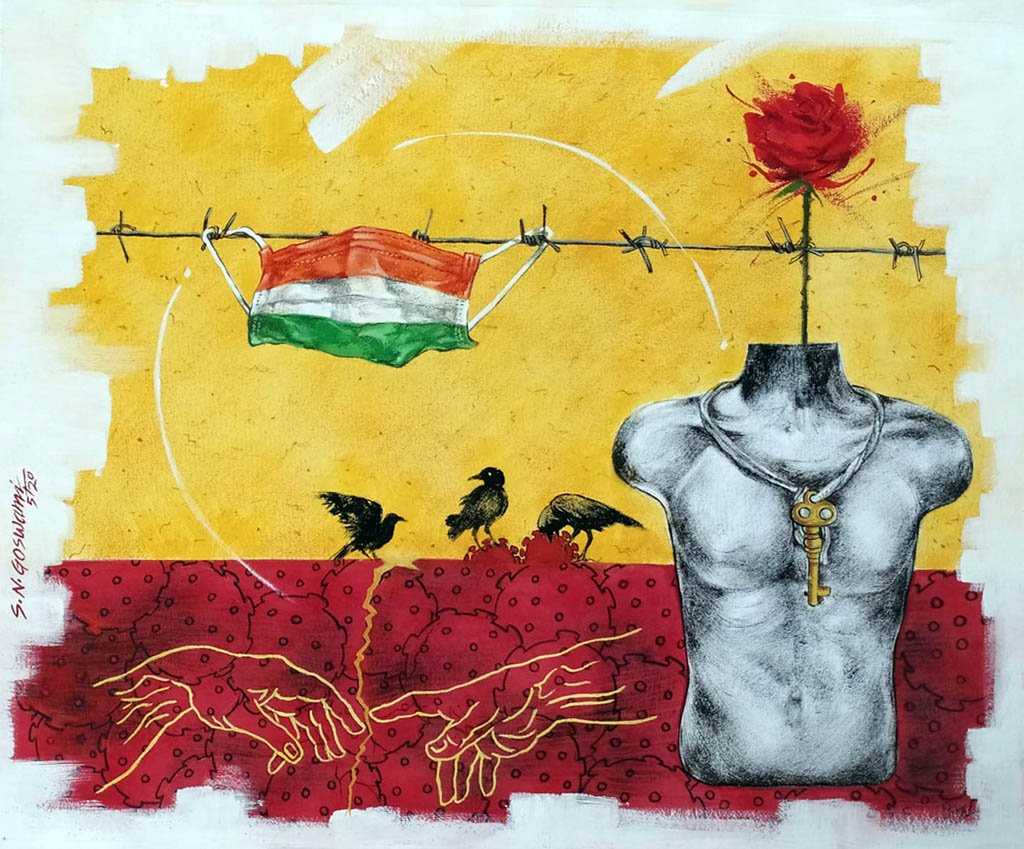This is an open reply to seemingly indifferent mockery, but actually a deep question: How ‘covid-19’ inspires artists to paint, why after all, any random issue is painted, displayed ‘naïvely’.
An interesting episode narrated by a Russian novelist Fyodor Dostoyevsky (1821-1881), in his well-known novel ‘The Idiot’ (1874) (ref 1) is a simple but complete answer to this: In this novel, one important character is Rogozhin, a character paralleled to a common man, and having inherited huge fortune from his father, madly in love with a woman. Rogozhin represents a passionate, instinctive love – as opposed to the central character of Prince Lev Nikolaevich Myshkin, a character compared to Jesus, imbibed in Christian love submerged in compassion.
Rogozhin instinctively likes and trusts the Prince when they first meet, but later develops a hatred for him out of jealousy. The reason being that in spite of illness, innocence and lack of social experience, which gives him an impression of a diminished intellect, Myshkin is actually a highly intelligent, self-aware empathic. Far from being an ‘idiot’, he is someone who thinks deeply about human nature, morality and spirituality, and expresses those thoughts in great transparency with anticipations and apprehensions. In this allusion, Dostoyevsky in his novel Idiot induces a painting entitled,
“The body of the dead Christ in the tomb” (1521) in oil and tempera on wood by a German artist and printmaker Hans Holbien (1497-1543): The Body of the Dead Christ in the Tomb, Hans Holbien (1521) Consider this picture in context of the following excerpt from the novel Idiot (2.4.1-10) (ref 2), ‘Over the door, however, there was one of strange and rather striking shape; it was six or seven feet in length, and not more than a foot in height. It represented the Saviour just taken from the cross’. The prince glanced at it, but took no further notice. He moved on hastily, as though anxious to get out of the house. But Rogozhin suddenly stopped underneath the picture.
‘I like looking at that picture,’ muttered Rogozhin
‘That picture! That picture!’ cried Myshkin, struck by a sudden idea. ‘Why, a man’s faith might be ruined by looking at that picture’!
‘So it is!’ said Rogozhin, unexpectedly’
While Hans Holbien is said to have painted a mere depiction of Christ in tomb; but the body of Christ denotes a degrading cadaver, owing to that fact that Holbien took as model, a body freshly fished out of the river Rhine to portray realistic dead flesh in the early stages of putrefaction. This painting, since its creation, has been delivering shock to the viewers, raising questions, instigating thought process in various social setups, including the fields of culture and literature like in case of Dostoevsky. Author presented varied reflections about the work – basically calling it a picture about faith: attempt of making or breaking the faith in mind of the audience on part of the artist; and its intention extending to the objective of redefining the social structure by its display: Some saw this painting as a virtuous portrayal of a deity – such that a dead body from that form could resuscitate, could only be a miracle- that Christ was.
This interpretation conveyed the message of belief: from decay, Christ rose in glory on the third day- the picture depicts the time between Good Friday and Easter Sunday when Christ was neither man, nor deity the time when he was dead. Paintings like this piece were produced to aid meditations on Christ’s Passion in the late medieval period; On the other hand, the painting was seen as a shocking grotesque depiction of that who was called Devine – the Christ suffering in his earthly life, depicted through an inconceivable physical deterioration that a body could suffer in a thin, rigid cadaver bearing marks of crucifixion. The son of God, depicted as a carcass of an ordinary human being – in state and fate. The painting was seen as a blasphemous portrayal of a deity.


Water colour, Acrylic colour on Handmade paper 24×30 inches
It was put to question if it was possible that a dead body from such level of degradation could resuscitate owing to a miracle.
Major preoccupation of Dostoyevsky in this Novel was to explore human psychology in the context of the troubled political, social and spiritual atmosphere of 19th-century. He took to depict the manner in which the painting had instigated interesting reactions on the part of sections of society, who vividly questioned if, the painting is an image of faith or an imagery of mockery towards faith, a revolt against the religion and conservatism, while at the same time, most interestingly, many interpreted the depiction of decay of the body of the Christ as a symbolic indication of the beginning of corruption….
The painting of the dead Christ, and its highlighting by Dostoevsky has been a vivid example of the capacity of art, well put in words by Oscar Wilde in his work ‘The soul of the man under socialism’ (1991):
By involvement of the audience, the artists make the art works more and more influential. In technical terms, it refers to a Pragmatic approach in making of art, wherein, as the words suggests, the purpose of art works, apart from the expression by the artists is also a search to affect the viewer/s by engaging them consciously, by sharing, displaying, publishing art works, such that the entire process has some practical implications on the individuals or on the social group/ society as a whole. Art work/s in here become/s a means of binding people in universal emotions, leading them towards common goals, mostly for the benefit of humanity and better perspective aiming better living. The thought process involved, on part of the artist, and next on part of the audience, inevitably presages a hope or desire to move to another level of living in reality or in expectation.
In these terms, the natural reaction of artists in painting Covid series may be an awe on the part of the artists to have witnessed such unforeseen situation, for others an intend to document the moments, and yet, for others a lookout for modifications required in the society to make the present and post covid period more acceptable to human survival and frugality.
Similar to the figure of horse, depicted perpetually by M.F. Hussain (Maqbool Fida Hussain, 1915-2011, Indian Painter), in his artworks, describing it as a symbol of grace and freedom (ref 4), the perpetual occurrence of a cage and locked windows holding human figures and faces, while the flora seems blossoming and fauna finds courage to roam free in atypical, human invaded lands, in various paintings by varirefous artists, may become a symbol of moment when man realised (or should have realised) the crux of idea to balance of nature through importance of limitations….. a painting of people in masks, when air quality index touched an imaginary excellent level may become an ideogram reminding man of his 2020 situation, to remember the lessons learnt, drawing attention to caution in future way of life… a mask may become a metaphor of emancipation….
As the Spanish painter Pablo Ruiz Picasso (1881-1973) expressed in dialogue with Brassai, French photographer (1899-1984) (ref3):
“No, the painting is not made to merely decorate the apartments. It is an offensive weapon and defensive against the enemy” And that is the very idea/aim/purpose/inspiration of making and sharing the covid series or various others …
1 The novel was first published serially in the journal ‘The Russian Messenger’ in 1868–69.
2 ‘Idiot’, 1874_ Fyodor Dostovesky_ Part 2. Chapter 4. Page 1 to 10 (2.4.1-10)
3 Article Horse as Metaphor for freedom/Alka Raghuvanshi_The Asian age_ e-paper issue 05.06.2020
4 Picasso vu par Brassaï (Musée Picasso Paris) (French Edition) –1987





